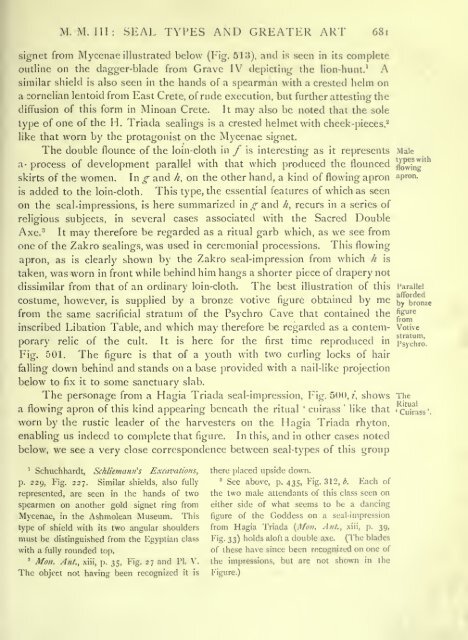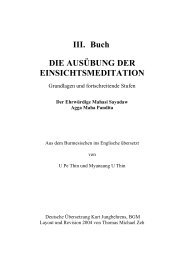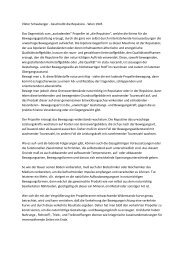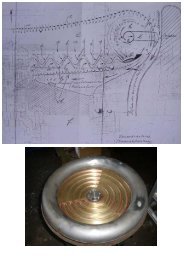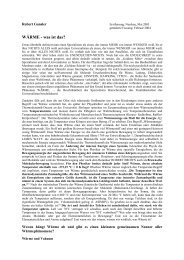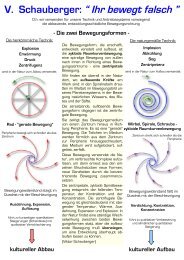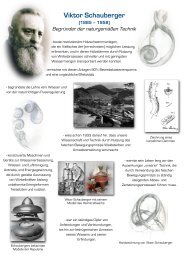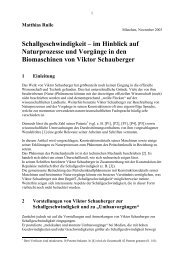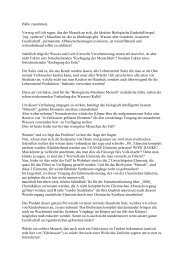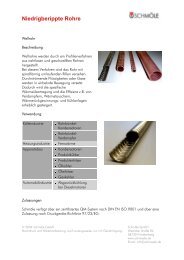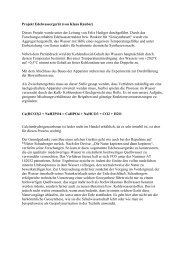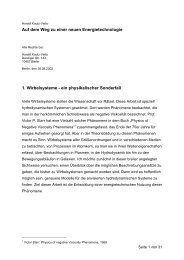- Page 1:
ssoo B
- Page 12:
(All NCI' I'IGl'KI 01 SNAKI (JODDES
- Page 16 and 17:
' Sw en a fc S "' q a c- O w 5 OS O
- Page 18 and 19:
vi THE PALACE OF MINOS, ETC. Early,
- Page 20 and 21:
viii THE PALACE OF MINOS, ETC. part
- Page 22 and 23:
x THE PALACE OF MINOS, ETC. has bee
- Page 24 and 25:
xii THE PALACE OF MINOS, ETC. evide
- Page 26 and 27:
xiv CONTENTS PAGE Pottery Light on
- Page 28 and 29:
xv i CONTENTS 271 13. M.M.II: STONK
- Page 30 and 31:
xviii CONTENTS Clay and Stone from
- Page 32 and 33:
I omb xx CONTENTS 27. M. M. Ill: (M
- Page 34 and 35:
' xxii CONTENTS Humorous and Demoni
- Page 36 and 37:
xxiv CONTENTS Fig. 478. Compound fo
- Page 38 and 39:
2 THE PALACE OF MINOS, ETC. reliefs
- Page 40 and 41:
THE PALACK OF MINOS, ETC. Knossian
- Page 42 and 43:
1 ! ' THE PALACE OF MINOS, ETC. ' A
- Page 44 and 45:
8 THE PALACE OF MINOS, ETC. intrusi
- Page 46 and 47:
' '' ' 10 THE PALACE OF MINOS, ETC.
- Page 48 and 49:
12 THE PALACE OF MINOS, ETC. Marble
- Page 50 and 51:
THE PALACE OE MINOS, ETC. Neolithic
- Page 52 and 53:
[6 THE PALACE OF MINOS. ETC. Reflex
- Page 54 and 55:
i8 THE PALACE OF MINOS, ETC. Eleven
- Page 56 and 57:
Cycladic Intercourse. Troadic Conne
- Page 58 and 59:
22 THE PALACE OF MINOS, ETC. Troadi
- Page 60 and 61:
THK PALACE OF MINOS, ETC. Trojan tr
- Page 62 and 63:
26 THE PALACE OF MINOS, ETC. The Ea
- Page 64 and 65:
2 8 THE PALACE OE MINOS, ETC. Final
- Page 66 and 67:
Arbitrary Element in Stratigraphica
- Page 68 and 69:
1. THE NEOLITHIC STAGE IN CRETE ' M
- Page 70 and 71:
34 THE PALACE OF MINOS, ETC. Sectio
- Page 72 and 73:
THE PALACE OF MINOS, ETC. Lower Neo
- Page 74 and 75:
' ' THE PALACE OF MINOS. ETC. Evolu
- Page 76 and 77:
THE PALACE OF MINOS, ETC. FIG. 7. N
- Page 78 and 79:
42 THE PALACE OF MINOS, ETC. Till N
- Page 80 and 81:
44 THE PALACE OF MINOS. ETC. 4. a.
- Page 82 and 83:
f - * IMG. 12. NEOLITHIC CI.AY IDOL
- Page 84 and 85:
48 THE PALACE OF MINOS, ETC.
- Page 86 and 87:
Evolution of Extended Types of Ston
- Page 88 and 89:
THE PALACE OF MINOS, ETC. Neolithic
- Page 90 and 91:
54 THE PALACE OE MINOS, ETC. Neolit
- Page 92 and 93:
Aspectsof E. M. I. Transi- Sub- Neo
- Page 94:
5 8 THE PALACE OF MINOS, ETC. cups
- Page 97 and 98:
' EARLY MINOAN I (WITH SUB-NEOLITHI
- Page 99 and 100:
FlG. 21. ROCK-SHELTER, GOURNIA. (f
- Page 101 and 102:
EARLY MINOAN I (WITH SUB-NEOLITHIC)
- Page 103 and 104:
EARLY MINOAN I (WITH SUB-NEOLITHIC)
- Page 105 and 106:
I FIG. 29 (| f.). FIG. 30 ( c.). PR
- Page 107 and 108:
KARLY MINOAN 1 (WITH SUB-NEOLITHIC)
- Page 109 and 110:
3 . EARLY MINOAN II (F, M. II) Acme
- Page 112 and 113:
74 THE PALACE OF MINOS, ETC. Painte
- Page 114 and 115:
7 6 THE PA LACK OF MINOS, ETC. FIG.
- Page 116 and 117:
THE PALACE OF MINOS, ETC. Mottled o
- Page 118 and 119:
46, So THE .PALACE OF MINOS, ETC. I
- Page 120 and 121:
' 82 THE PALACE OF MINOS, ETC. Doub
- Page 122 and 123:
8 4 THE PALACE OE MINOS, ETC. Compa
- Page 124 and 125:
86 THE PALACE OF MINOS, ETC. FIG. 5
- Page 126 and 127:
88 THE PALACE OF MINOS, ETC. BOW? o
- Page 128 and 129:
' THE PALACE OF MINOS, ETC. E. M. I
- Page 130 and 131:
92 THE PALACE OF MINOS, ETC. Reacti
- Page 132 and 133:
94 THE PALACE OF MINOS, ETC. Cylind
- Page 134 and 135:
XXI. 14 FIG. 67. JEWELLERY FROM MOC
- Page 136 and 137:
9 8 THE PALACE OF MINOS, ETC. inter
- Page 138 and 139:
IOO THE PALACE OF MINOS, ETC. silvc
- Page 140 and 141:
102 THE PALACE OF MINOS, ETC. D ve
- Page 142 and 143:
Early filling of one excavated unde
- Page 144 and 145:
io6 THE PALACE OF MINOS, ETC. Secon
- Page 146 and 147:
io8 THE PALACE OF MINOS, ETC. Knoss
- Page 148 and 149:
1 IO THE PALACE OF MINOS, ETC. of t
- Page 150 and 151:
ii2 THE PALACE OF MINOS, ETC. inter
- Page 152 and 153:
114 THE PALACE OF MINOS, ETC. North
- Page 154 and 155:
u6 THE PALACE OF MINOS, ETC. FIG. 8
- Page 156 and 157:
V ^ ._. ^im m ,- //r.VS ^ J7 8 10 F
- Page 158 and 159:
I2O THE PALACE OF MINOS, ETC. Impre
- Page 160 and 161:
122 THE PALACE OF MINOS, ETC. Meand
- Page 162 and 163:
124 THE PALACE OF MINOS ETC. seals
- Page 164 and 165:
126 THE PALACE OF MINOS, ETC. Egypt
- Page 166 and 167:
128 THE PALACE OF MINOS, ETC. walls
- Page 168 and 169:
B H X IT. O h H O p O f. o o z o K
- Page 170 and 171:
132 THE PALACE OF MINOS, ETC. Large
- Page 172 and 173:
134 THE PALACE OF MINOS, ETC. also
- Page 174 and 175:
136 THE PALACE OF MINOS, ETC. that
- Page 176 and 177:
THE PALACE OF MINOS, ETC. Minoan Ag
- Page 179 and 180:
M. M. I: FOUNDATION OF KNOSSIAN PAL
- Page 181 and 182:
' M. M. I: FOUNDATION OF KNOSS1AX P
- Page 184 and 185:
146 THE PALACE OF MINOS, ETC. at th
- Page 186 and 187:
' 148 THE PALACE OF MINOS, ETC. Tra
- Page 188 and 189:
150 THE PALACE OF MINOS, ETC. Tende
- Page 191 and 192:
M.M. I: PEAK SANCTUARY: 'THK TuMI!
- Page 193 and 194:
Fig. 112. RIDGE OF Mr. JUKTAS FROM
- Page 195 and 196:
M. M. I: PEAK SANCTUARY: 'THE TOMB
- Page 197 and 198:
M. M. I: PEAK SANCTUARY: 'THK TOMB
- Page 199 and 200:
MM. I: PEAK SANCTUARY: 'THE TOMB OF
- Page 201 and 202:
-' The M.M. I: PEAK SANCTUARY: 'THE
- Page 203 and 204:
1 M. M. I: CERAMIC PHASES 165 and,
- Page 205 and 206:
o - _
- Page 207 and 208:
M. M. I: CERAMIC PHASH.s 169 the fl
- Page 209 and 210:
M. M. I: CERAMIC PI I ASKS 171 had
- Page 211 and 212:
M. M. I: CERAMIC PHASES '73 latter
- Page 213 and 214:
M.M.I: CERAMIC PHASES 75 in Fig. 1I
- Page 215 and 216:
M.M.I: CERAMIC PHASES 177 objects o
- Page 217 and 218:
' M. M. I : CERAMIC PHASES 179 I a
- Page 219 and 220:
M.M.I: CERAMIC PHASES 181 IMC;. 129
- Page 221 and 222:
M.M.I: CERAMIC PHASES '83 I z o B a
- Page 223 and 224:
M.M.I: CERAMIC PHASES 185 teristic
- Page 225 and 226:
FIG. 135. FLOOR OF CHAMBER BELOW WE
- Page 227 and 228:
M.M.I: CERAMIC PHASES 189 other cas
- Page 229 and 230:
8. M. M. I : (D) METAL-WORK, SEALS,
- Page 231 and 232:
M. M. I : METAL-WORK, SEALS, FOREIG
- Page 233 and 234:
M. M. I : METAL-WORK, SEALS, FOREIG
- Page 235 and 236:
M. M. I : METAL-WORK, SEALS, FOREIG
- Page 237 and 238:
M. M. I : METAL-WORK, SEALS. FOREIG
- Page 239 and 240:
M. M. I : METAL-WORK, SEALS, FOREIG
- Page 242 and 243:
LATER SOUTH-WEST QUARTER ;......: 5
- Page 244 and 245:
204 THE PALACE OF MINOS, ETC. (A, 1
- Page 246 and 247:
206 THE PALACE OF MINOS, ETC. disco
- Page 248 and 249:
208 THE PALACE OF MINOS, ETC. FIG.
- Page 250 and 251:
2IO THE PALACE OF MINOS, ETC. ' Kal
- Page 252 and 253:
212 THE PALACE OF MINOS, ETC. early
- Page 254 and 255:
214 THE PALACE OF MINOS, ETC. The i
- Page 256 and 257:
216 THE PALACE OF MINOS, ETC. N.\V.
- Page 258 and 259:
218 THE PALACE OF MINOS, ETC. Purif
- Page 260 and 261:
UJ
- Page 262 and 263:
222 THE PALACE OF MINOS, ETC. Colum
- Page 264 and 265:
224 THE PALACE OF MINOS, ETC. Other
- Page 266 and 267:
226 THE PALACE OF MINOS, ETC. Each
- Page 268 and 269:
il COURT OF DISTAFFS lo 3 FIG. 1 p.
- Page 270 and 271:
228 THE PALACE OF MINOS, ETC. Shaft
- Page 272:
230 THE PALACE OF MINOS, ETC. leavi
- Page 275:
ff
- Page 278:
' THE PALACE OF MINOS, ETC. Rope Mo
- Page 281 and 282:
' , /aroe M.M. II : ROYAL POTTERY S
- Page 283 and 284:
M. M. II : ROYAL POTTERY STORES (CE
- Page 285 and 286:
M. M. II : ROYAL POTTERY STORES (CE
- Page 287 and 288:
\
- Page 291 and 292:
M. M. II : ROYAL POTTERY STORES (CE
- Page 295 and 296:
M. M. ii : ROYAL POTTERY STORES (CE
- Page 297 and 298:
M.M. II : ROYAL POTTERY STORES (CER
- Page 300 and 301:
PLATE III CO o tS> CO o z o o OS E
- Page 303 and 304:
M. M. II : ROYAL POTTERY STORES (CE
- Page 305 and 306:
M. M. II: LOOM-WEIGHT DEPOSIT (CERA
- Page 307:
. o : . . ;: k -. :/ .. .. . '-"*.*
- Page 310 and 311:
252 THE PALACE OF MINOS, ETC. a gre
- Page 312 and 313:
254 THE PALACE OE MINOS, ETC. 1 the
- Page 314 and 315:
1 256 THE PALACE OF MINOS, ETC. amp
- Page 316 and 317:
258 THE PALACE OF MINOS, ETC. Disk
- Page 318 and 319:
260 THE PALACE OF MINOS, ETC. Light
- Page 320 and 321:
FIG. 194. M. M. II POLYCHROME CERAM
- Page 322:
264 THE PALACE OF MINOS, ETC. of th
- Page 327 and 328:
M.M. II: LOOM-WEIGHT DEPOSIT (CERAM
- Page 329 and 330:
M.M. II: LOOM-WEIGHT DEPOSIT (CERAM
- Page 331 and 332:
' MM. II: LOOM-WEIGHT DEPOSIT (CERA
- Page 333 and 334:
IT,. M. M. II: (E) THE HIEROGLYPHIC
- Page 335 and 336:
( MM. II: HIEROGLYPHIC DEPOSIT: SEA
- Page 337 and 338:
M.M. II: HIEROGLYPHIC DEPOSIT: SEAL
- Page 339 and 340:
M.M. II: HIEROGLYPHIC DEPOSIT: SEAL
- Page 341 and 342:
M. M. II: HIEROGLYPHIC DEPOSIT: SEA
- Page 343 and 344:
M. M. II: HIEROGLYPHIC DEPOSIT: SEA
- Page 345 and 346:
M.M. II: HIEROGLYPHIC DEPOSIT: SEAL
- Page 347 and 348:
M. M. II: HIEROGLYPHIC DEPOSIT: SEA
- Page 349 and 350:
' M. M. II: EGYPTIAN MONUMENT AND R
- Page 351 and 352:
M.M. II: EGYPTIAN MONUMENT AND RELA
- Page 353 and 354:
M.M. II: EGYPTIAN MONUMENT AND RELA
- Page 355 and 356:
M. M. II: EGYPTIAN MONUMENT AND REL
- Page 357 and 358:
M.M. II: EGYPTIAN MONUMENT AND RELA
- Page 359 and 360:
M. M. II: EGYPTIAN MONUMENT AND REL
- Page 361 and 362:
M.M. II: EGYPTIAN MONUMENT AND RELA
- Page 363 and 364:
J 15- M. M. II : (G) THE TOWN MOSAI
- Page 365 and 366:
M. M. II. THE TOWN MOSAIC 303 Unexp
- Page 367 and 368:
M.M. II. THE TOWN MOSAIC 305 Restor
- Page 369:
tff I,,; I (Wwwc ' '' """ " ""1''
- Page 372 and 373:
308 THE PALACE OF MINOS, ETC. 1 'I
- Page 374 and 375:
' 310 THE PALACE OF MINOS, ETC. Neg
- Page 376 and 377:
312 THE PALACE OF MINOS, ETC. Paint
- Page 378 and 379:
THE PALACE OF MINOS, ETC. Scale Con
- Page 380 and 381:
THE PALACE OF MINOS, ETC. Appearanc
- Page 382 and 383:
3 i8 THE PALACE OF MINOS, ETC. Imme
- Page 384 and 385:
320 THE PALACE OF MINOS, ETC. again
- Page 386 and 387:
\22 THE PALACE OF MINOS, ETC. diate
- Page 388 and 389:
GRAND STAIRCASE, FIG. 237. SECOND A
- Page 390 and 391:
326 THE PALACE OF MINOS, ETC. Miner
- Page 392:
328 THE PALACE OF MINOS, ETC. the w
- Page 396 and 397:
330 THE PALACE OF MINOS, ETC. the f
- Page 398 and 399:
u 2 I PU b, O o z c z c 8 K en O1 o
- Page 400 and 401:
334 THE PALACE OF MINOS, ETC. Latri
- Page 402 and 403:
336 THE PALACE OF MINOS, ETC. posit
- Page 405 and 406:
BE . ; O w a U. Ui O C Z 2 O Z - b)
- Page 407 and 408:
M.M. Ill: THE DOMESTIC QUARTER 341
- Page 409:
P. 34'
- Page 412 and 413:
344 THE PALACE OF MINOS, ETC. Use o
- Page 414 and 415:
346 THE PALACE OF MINOS, ETC. Late
- Page 417 and 418:
' MM. Ill: THE DOMESTIC ol'AKTEK 34
- Page 419 and 420:
M. M. Ill: THE DOMESTIC QUARTER 351
- Page 421 and 422:
M. M. Ill: THE DOMESTIC QUARTER 353
- Page 423 and 424:
M. M. Ill: THE DOMESTIC QUARTER 355
- Page 425 and 426:
M. M. Ill : THE DOMESTIC QUARTER 35
- Page 427:
IMG. 257. a, b, EGYPTIAN I'AI.ACK S
- Page 430 and 431:
1 8. M. M. Ill : ' (C) NORTH-EAST B
- Page 432 and 433:
362 THE PALACE OF MINOS, ETC N.E. R
- Page 434 and 435:
564 THE PALACE OF MINOS, ETC. M.M.
- Page 436 and 437:
Probably Workmen's Quarters. Room o
- Page 438 and 439:
3 68 THE PALACE OF MINOS, ETC. same
- Page 440 and 441:
370 THE PALACE OF MINOS, ETC. basem
- Page 442 and 443:
372 THE PALACE OF MINOS, ETC. The S
- Page 444 and 445:
374 THE PALACE OF MINOS, ETC. diago
- Page 446 and 447:
376 THE PALACE OF MINOS, ETC. a hin
- Page 448 and 449:
378 THE PALACE OF MINOS, ETC. these
- Page 450 and 451:
3 8o THE PALACE OF MINOS, ETC. Port
- Page 452 and 453:
3 82 THE PALACE OF MINOS, ETC. of t
- Page 454 and 455:
THE PALACE OF MINOS, ETC. the inner
- Page 456 and 457:
386 THE PALACE OF MINOS, ETC. The N
- Page 459 and 460:
M.M. Ill: NORTH QUARTER AND ENTRANC
- Page 461 and 462:
M. M. Ill: NORTH QUARTER AND ENTRAN
- Page 463 and 464:
M. M. Ill: NORTH QUARTER AND ENTRAN
- Page 465 and 466:
M. M. Ill: NORTH QUARTER AND ENTRAN
- Page 467 and 468:
M. M. Ill: NORTH QUARTER AND ENTRAN
- Page 470:
398 THE PALACE OF MINOS, ETC. The e
- Page 473 and 474:
M. M. Ill: NORTH QUARTER AND ENTRAN
- Page 475 and 476:
M. M. Ill: NORTH QUARTER AND ENTRAN
- Page 477 and 478:
20. M. M. Ill: (E) NORTH-WEST BAILE
- Page 479 and 480:
M. M. Ill : NORTH-WEST BAILEY AND L
- Page 481 and 482:
M.M. Ill: NORTH-WEST BAILEY AND LUS
- Page 483 and 484:
M. M. Ill: NORTH-WEST BAILEY AND LU
- Page 485 and 486:
M.M.III: NORTH-WEST BAILEY AND LUST
- Page 487 and 488:
M.M. Ill: NORTH-WEST BAILEY AND LUS
- Page 489 and 490:
M.M.III: NORTH-WEST BAILEY AND LUST
- Page 491 and 492:
1 type in alabaster and diorite and
- Page 493 and 494:
M.M. Ill: NORTH-WEST BAILEY AND LUS
- Page 495 and 496:
$2i. M. M. Ill: (F) WEST PALACE REG
- Page 497 and 498:
M. M. Ill : WEST PALACE REGION ; DO
- Page 499 and 500:
M. M. Ill : WEST PALACE REGION ; DO
- Page 501 and 502:
M.M. Ill : WEST PALACE REGION; DOUB
- Page 503 and 504:
M. M. III. WEST PALACE REGION ; DOU
- Page 505 and 506:
M. M. Ill : WEST PALACE REGION ; DO
- Page 507 and 508:
M. M. Ill: WEST PALACE REGION; DOUB
- Page 509 and 510:
M. M. Ill : WEST PALACE REGION ; DO
- Page 511 and 512:
M. M. Ill : WEST PALACE REGION; DOU
- Page 513 and 514:
M. M. Ill : WEST PALACE REGION ; DO
- Page 515 and 516:
M. M. Ill: WEST PALACE REGION; DOUB
- Page 517 and 518:
M. M. Ill: WEST PALACE REGION; DOUB
- Page 519 and 520:
M. M. Ill: WEST PALACE REGION; DOUB
- Page 521 and 522:
M.M. III. FLOOR-CISTS OF W. PALACE
- Page 523 and 524:
M. M. III. FLOOR-CISTS OF W. PALACE
- Page 525:
C LONOGLIERY-P LAN4 StCTlON Of ClST
- Page 528 and 529:
454 THE PALACE OF MINOS, ETC. doubt
- Page 530 and 531:
456 THE PALACE OF MINOS, ETC. gypsu
- Page 532 and 533:
458 THE PALACE OF MINOS, ETC. inclu
- Page 534 and 535:
460 THE PALACE OF MINOS, ETC. as is
- Page 536 and 537:
Three Stages of Magazine Entrance.
- Page 538 and 539:
Superficial Cists of later Shrine.
- Page 540 and 541:
466 THE PALACE OF MINOS, ETC. Dis-
- Page 542 and 543:
4 68 THE PALACE OF MINOS, ETC. mass
- Page 544 and 545:
470 THE PALACE OF MINOS, ETC. a pet
- Page 546:
472 THE PALACE OF MINOS, ETC. descr
- Page 551 and 552:
M. M. Ill: THE TEMPLE REPOSITORIES
- Page 553 and 554:
M. M. Ill: THE TEMPLE REPOSITORIES
- Page 555 and 556:
;i M.M. Ill: THE TEMPLE REPOSITORIE
- Page 557 and 558:
M. M. Ill: THE TEMPLE REPOSITORIES
- Page 559 and 560:
M.M. Ill: THE TEMPLE REPOSITORIES 4
- Page 561 and 562:
M. M. Ill: THE TEMPLE REPOSITORIES
- Page 563 and 564:
and it M. M. Ill: THE TEMPLE REPOSI
- Page 565 and 566:
M. M. Ill: KNOSSIAN FAIENCE: THE BE
- Page 567 and 568:
M. M. Ill: KNOSSIAN FAIENCE: THE BE
- Page 569 and 570:
M.M. Ill: KNOSSIAN FAIENCE: THE BEA
- Page 571 and 572:
M.M. Ill: KNOSSIAN FAIENCE: THE BEA
- Page 573 and 574:
25. M. M. Ill: (K) THE SNAKE GODDES
- Page 575 and 576:
M.M. Ill: THE SNAKE GODDESS AND REL
- Page 577 and 578:
M. M. Ill: THE SNAKE GODDESS AND RE
- Page 579 and 580:
M.M. Ill: THE SNAKE GODDESS AND REL
- Page 581 and 582:
M.M. Ill: THE SNAKE GODDESS AND REL
- Page 583 and 584:
M. M. Ill: THE SNAKE GODDESS AND RE
- Page 585 and 586:
M.M. Ill: THE SNAKE GODDESS AND REL
- Page 587 and 588:
M.M. Ill: THE SNAKE GODDESS AND REL
- Page 589 and 590:
M.M. Ill: THE SNAKE GODDESS AND REL
- Page 591 and 592:
M.M. Ill: THE SNAKE GODDESS AND REL
- Page 593 and 594:
M. M. Ill: THE SNAKE GODDESS AND RE
- Page 595 and 596:
M. M. Ill: THE SNAKE GODDESS AND RE
- Page 597 and 598:
M.M. Ill: THE SNAKE GODDESS AND REL
- Page 599 and 600:
M.M. Ill: THE SNAKE GODDESS AND REL
- Page 601 and 602:
M.M. Ill: THE SNAKE GODDESS AND REL
- Page 603 and 604:
M. M. Ill: MINOAN FRKSCO: WALL PAIN
- Page 605 and 606:
M. M. Ill: MINOAN FRESCO: WALL PAIN
- Page 607 and 608:
M. M. Ill: MINOAN FRESCO: WALL PAIN
- Page 609 and 610:
M.M. Ill: MINOAN FRESCO: WALL PAINT
- Page 611 and 612:
1 M.M. Ill: MINOAN FRKSCO : WALL PA
- Page 613 and 614:
M. M. Ill: MINOAN FRESCO: WALL PAIN
- Page 616:
PLATE VI to J h w 3 a. h z
- Page 620 and 621:
538 THE PALACE OF MINOS, ETC. fragm
- Page 622 and 623:
540 THE PALACE OF MINOS, ETC. Knoss
- Page 624 and 625:
542 THE PALACE OF MINOS, ETC. It ha
- Page 626 and 627:
544 THE PALACE OF MINOS, ETC. Repre
- Page 628 and 629:
54 6 THE PALACE OF MINOS, ETC. Fine
- Page 630 and 631:
Votive Arrows. 548 THE PALACE OF MI
- Page 632 and 633:
550 THE PALACE OF MINOS, ETC. golde
- Page 634 and 635:
2-j. M. M. Ill : (M) THE PALACE POT
- Page 636 and 637:
554 THE PALACE OF MINOS, ETC. Natur
- Page 638 and 639:
550 THE PALACE OF MINOS, ETC. theor
- Page 640:
' The ' , 55 8 THE PALACE OF MINOS,
- Page 644 and 645:
Bird type 5 6o THE PALACE OF MINOS,
- Page 646 and 647:
5 6 2 THE PALACE OF MINOS, ETC. ' P
- Page 648 and 649:
564 THE PALACE OF MINOS, ETC. Pitho
- Page 650 and 651:
FIG. 412. KNOUBKD AND OTHER VESSELS
- Page 652 and 653:
5 68 THE PALACE OF MINOS, ETC. kind
- Page 654 and 655:
570 THE PALACE OF MINOS, ETC. been
- Page 656 and 657:
' 572 THE PALACE OF MINOS, ETC. poi
- Page 658 and 659:
574 THE PALACE OF MINOS, ETC. proba
- Page 660 and 661:
576 THE PALACE OF MINOS, ETC. Later
- Page 662 and 663:
578 THE PALACE OF MINOS, ETC. Magaz
- Page 664 and 665:
! 5 8o THE PALACE OF MINOS, ETC. '
- Page 666 and 667:
THE PALACE OF MINOS, ETC. Magazine
- Page 668 and 669:
584 THE PALACE OF MINOS, ETC. a qua
- Page 670 and 671:
586 THE PALACE OF MINOS, ETC. Age.
- Page 672 and 673:
588 THE PALACE OF MINOS, ETC. succe
- Page 674 and 675:
590 THE PALACE OF MINOS, ETC. early
- Page 676 and 677:
Monochrome decoration again general
- Page 678 and 679:
Polychrome ' Rhyton ' ofOstrich- Eg
- Page 681 and 682:
M. M. Ill: SURVIVALS OF CERAMIC POL
- Page 684 and 685:
Line cor the se-' left. rownis, ; h
- Page 687 and 688:
M.M. Ill: SURVIVALS OF CERAMIC POLY
- Page 689 and 690:
M. M. Ill: SURVIVALS OF CERAMIC POL
- Page 691 and 692:
M.M. Ill: SURVIVALS OF CERAMIC POLY
- Page 693 and 694:
M. M. Ill: SURVIVALS OF CERAMIC 1'O
- Page 695 and 696:
M. M. Ill: SURVIVALS OF CERAMIC POL
- Page 697 and 698:
M.M.III: SURVIVALS OF CERAMIC POLYC
- Page 699 and 700:
M. M. Ill: SURVIVALS OF CERAMIC POL
- Page 701 and 702:
M. M. Ill: SURVIVALS OF CERAMIC POL
- Page 703 and 704:
M.M. Ill: LINEAR SCRIPT A AND ITS S
- Page 705 and 706:
M. M. Ill: LINEAR SCRIPT A AND ITS
- Page 707 and 708:
M.M. Ill: LINEAR SCRIPT A AND ITS S
- Page 709 and 710:
M. M. Ill: LINEAR SCRIPT A AND ITS
- Page 711 and 712:
M.M. Ill: LINEAR SCRIPT A AND ITS S
- Page 713 and 714:
M.M. Ill: LINEAR SCRIPT A AND ITS S
- Page 715 and 716:
M. M. Ill : LINEAR SCRIPT A AND ITS
- Page 717 and 718:
M. M. Ill : LINEAR SCRIPT A AND ITS
- Page 719 and 720: M. M. Ill : LINEAR SCRIPT A AND ITS
- Page 721 and 722: M. M. Ill : LINEAR SCRIPT A AND ITS
- Page 723 and 724: M. M. Ill . LINEAR SCRIPT A AND ITS
- Page 725 and 726: M. M. Ill : LINEAR SCRIPT A AND ITS
- Page 727 and 728: M. M. Ill : LINEAR SCRIPT A AND ITS
- Page 729 and 730: M. M. Ill : LINEAR SCRIPT A AND ITS
- Page 731 and 732: M.M. Ill: LINEAR SCRIP'K A AND ITS
- Page 733 and 734: M.M. Ill: LINEAR SCRIPT A AND ITS S
- Page 735 and 736: M.M. Ill: LINEAR SCRIPT A AND ITS S
- Page 737 and 738: 3- THE PHAESTOS DISK IN ITS MINOAN
- Page 739 and 740: 1 THIC I'HAKSTOS DISK 649 Around an
- Page 741 and 742: THE PHAESTOS DISK 651 with the othe
- Page 743 and 744: THE PHAESTOS DISK 653 fish, No. 33,
- Page 745 and 746: THE PHAHSTOS DISK 655 shows a certa
- Page 747 and 748: THE PHAESTOS DISK 657 the same Moth
- Page 749 and 750: THE FHAESTOS DISK 659 regard the wh
- Page 751 and 752: THE PHAESTOS DISK 661 signification
- Page 753 and 754: THE PHAESTOS DISK 663 the form of s
- Page 755 and 756: THE PHAESTOS DISK 665 c;ips with fe
- Page 757 and 758: . THE PHAESTOS DISK 667 the round s
- Page 759 and 760: 31- M. M. Ill: (P). SEAL TYPES AND
- Page 761 and 762: M. M. Ill: SEAL TYPES AND GREATER A
- Page 763 and 764: M. M. Ill: SEAL TYPES AND GREATER A
- Page 765 and 766: M. M. Ill: SEAL TYPES AND GREATER A
- Page 767 and 768: M. M. Ill: SEAL TYPES AND GREATER A
- Page 769: M. M. Ill: SKAL TYPES AND GREATER A
- Page 773 and 774: M. M. Ill: SEAL TYPES AND GREATER A
- Page 775 and 776: M. M. Ill: SEAL TYPES AND GREATER A
- Page 777 and 778: M. M. Ill: SEAL TYPES AND GREATER A
- Page 779 and 780: M. M. Ill : SEAL TYPES AND GREATER
- Page 781 and 782: M. M. Ill: SKAL TYPES AND GREATER A
- Page 783 and 784: M. M. Ill: SEAL TYPES AND GREATER A
- Page 785 and 786: M. M. Ill: SEAL TYPES AND GREATER A
- Page 787 and 788: M. M. Ill: SEAL TYPES AND GREATER A
- Page 789 and 790: M. M. Ill: SEAL TYPES AND GREATER A
- Page 792 and 793: O2 THE PALACE OF MINOS, ETC. Variat
- Page 794 and 795: 704 THE PALACE OF MINOS, ETC. Under
- Page 796 and 797: 706 THE PALACE OF MINOS, ETC. ' par
- Page 798 and 799: 708 THE PALACE OF MINOS, ETC. Mythi
- Page 800 and 801: yio THE PALACE OF MINOS, ETC. of th
- Page 802 and 803: 712 THE PALACE OF MINOS, ETC. Crest
- Page 804 and 805: THE PALACE OF MINOS, ETC. The evide
- Page 806 and 807: ' .' 7 i6 THE PALACE OF MINOS, ETC.
- Page 808 and 809: 7 i8 THE PALACE OF MINOS, ETC. stre
- Page 810 and 811: 1 Comparison with Mycenae Daggers.
- Page 812 and 813: J PRINTED IN ENGLAND AT THK OXFORD
- Page 815: SUPPLEMENTARY PLATE II.
- Page 819: SUI'I'I KMIMAKV I'l.ATK IV M. M. II
- Page 823:
Sfl'l'l I Ml N I \KV I'l Ml- VI.
- Page 827:
i - Sl'ITI 1 MhM \l:\ I'l Ml VIII.
- Page 831:
PIIIAR OF EAST PILLAR ROOM. Kxo>>os
- Page 841:
it- PLEASE DO NOT REMOVE CARDS OR S


